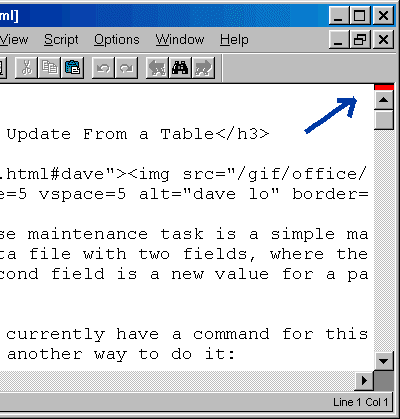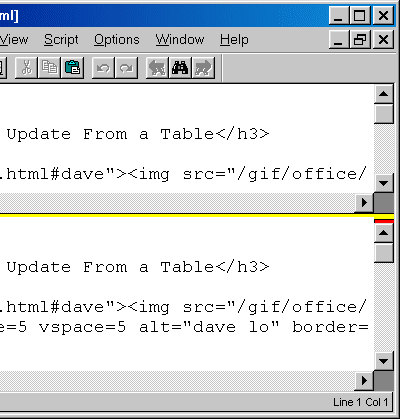


What's Up, DOCumentation? 2001 # 2
March 2001
From:
- Bob Green, President
- Mike Shumko, Editor
To: Users of Robelle Software
Re: News of the HP e3000 and Robelle, 2001 #2
What You Will Find in This Newsletter:
- Ecometry Corp. Selects Qedit for Windows
- Suprtool Case Study: Chartway
- New N-Class and A-Class Servers
- What to Tell a Newcomer?
- Improvements to Robelle Website
- Calendar of Events
- Replace Quiz Links With Faster Suprtool
- Suprtool Tip: Update From a Table
- What Is That Funny Red Bar?
- Newsletter Distribution and Format Choices
Ecometry Corp. Selects Qedit for Windows

Ecometry Corporation has adopted Qedit for Windows Client/Server Editor for internal use across three core departments. A site license enables Ecometry's programming team to use Qedit for Windows as the tool of choice for source code development. The Client Services group will be using Qedit for Windows to create and modify job streams and Suprtool scripts for customers. Qedit for Windows will also be used by Ecometry's Customer Training team in Delray Beach, Florida, to provide customers taking classes with a modern interface to HP e3000 files.

Ecometry Corp.'s purchase of Qedit for Windows echoes the growing popularity of this easy-to-use client/server editor within Ecometry's client base. Over the last year, nearly twenty customers have adopted Qedit for Windows, including recent purchases by Lego Systems, Inc., Urban Outfitters, and Design within Reach, to name a few.
Related stories and links:
- Ecometry users: Be sure to check out the special Ecometry section of our website for more information.

Suprtool Case Study: Chartway
Nicky Gunther, Robelle account rep and marketer, has done some research on Chartway Federal Credit Union, a user of the Summit application suite and Robelle's Suprtool.

Recently, there was a marketing initiative at Chartway to make debit card service available to more members. A mass mailing campaign was targeted to members whose profiles matched the following criteria: current ATM card user, direct deposit from employer, and average daily checking balance greater than $500.
Suprtool's powerful selection criteria allowed them to select records from one dataset (e.g., members with ATM cards) to use in qualifying records in another dataset (e.g., members who receive direct deposit). With Suprtool, this process was very efficient because the serial read of a dataset with Suprtool is far faster than trying to link each record by key value.
The next step was to actually create the debit cards. This process is normally done interactively through two separate screens in the Spectrum application, one to collect the ACTH record (name of the card holder) and one to collect the ATEX record (limits on the card).
Instead, Suprtool was used to do the selections (i.e., which members to give cards to) and build the input values for the ACTH and ATEX records. Then Suprtool formatted the data into the layout expected by the Summit program. Chartway then created 30,000 cards in three batches of 10,000 each, automating the card-making process by feeding the Suprtool-generated input files into the card application.
[Nicky Gunther, Robelle Sales and Marketing]

New N-Class and A-Class Servers
The HP e3000 A-class server is small, fast and inexpensive. It offers up to 65 percent more performance than previous entry-level e3000 servers and is available with 110 or 140 MHz processors, up to 2-way multi-processing, and supports up to 8 GB of memory.
The N-class server is a fast, affordable, mid-range and high-end system with up to 35 percent more power than its highest performing predecessor -- the 12-way 997 server. It offers 220, 330, 440 and 550 MHz processors, up to 4-way multi-processing, and supports up to 16 GB of memory.
Related stories and links:
- HP press release
- 3kworld Cheat Sheet: very useful, with highlights of the new technology
- HP e3000 Advisor article by Winston Prather quoting Neil Armstrong
Robelle Tests the New Servers
By Neil Armstrong, Robelle Senior ProgrammerIn December 2000, I had the opportunity to test the new N-class servers on MPE/iX 7.0. These new N-class servers (and the smaller A-class servers) have the new PCI hardware, and much of the underlying IO layer has been re-written to support this new hardware.
I installed our test suites and ran all of our tests in a fraction of the time it takes to run our test suites in our lab at our home office in Surrey BC. This was done without changes to our software, a recompile, nothing.
The NM version of our test suite typically takes 80 minutes on a 968 LX with no users. On the new 440 MHz N-Class server I was using the test suite took only 15 minutes.
This is a huge time savings.
I did some custom tests extracting 5GB of data, sorting and outputting the data. While watching the process with Glance I saw IO rates exceeding 400 IO's per second. Previous to this testing, the highest rates that I saw on a customer's 997-4 way was approximately 95 IO's per second. The N-class testing was done with the files "fflushed" from memory to ensure that we stressed the IO subsystem as much as possible.
One of the most impressive tests was the reading and output of a 5GB dataset, with the comparison a 10 byte key value using Suprtool's Table feature, with all 5GB of data selected. It was done in 6 minutes 38 seconds. With the faster memory and processors of late the new PCI IO brings IO rates more in line or balanced with the system as a whole.
These were some of the fastest HP e3000 servers I have ever seen, and this new technology extends the performance curve beyond anything I had ever imagined for the HP e3000.
[Neil Armstrong, Robelle Senior Programmer]
Unlimited Licenses on A and N-Class
Ron Seybold of the 3000 Newswire has written about the licensing on HP's new A-class and N-class servers. HP has pressed Reset on their pricing and now allows unlimited users on any new server. Read Ron's article on 3kworld, with additional news on unbundling of Allbase, phased introduction of MPE/iX 7.0, and Enhydra.
New Servers Have 128GB Files
3kworld.com is carrying a report from the 3000 Newswire that the first release of MPE/iX for the new N and A-Class servers will expand the maximum file size from 4GB to 128GB. Originally, this was scheduled for a later release.

What to Tell a Newcomer?
People who have never used the HP e3000 are often overwhelmed when an e3000 is dropped on their desk to support (in addition to the PC network, AS/400 and UNIX boxes they already support). There are a lot of links to e3000 material on the web (see our About the e3000 page for example), but which are the best pages for newcomers, and in what order?
We are putting together a "New to the 3000" web page, so send your suggestions and ideas to bgreen@robelle.com
TurboIMAGE Casserole
The full title of this tutorial is "TurboIMAGE Casserole: A Careful Mix of Design and Maintenance". Author Brian Duncombe of Triolet Systems has created a good introduction to IMAGE database design and performance improvement, including sample output from Robelle's HowMessy utility. The tutorial is especially for users who may not have the ability to change the application source code or the database design. Read the paper in PDF format on his web site.
e3000 Basics: Learning MPE/iX
Allegro Consultants, Inc, creators of numerous technical tools for the e3000, have a nice page for newcomers, with links to learning resources that are either internal to the e3000 system or available on the Internet.
e3000 Web Sites: SearchHP
SearchHP is a search engine for information about HP computers, both MPE/iX and HP-UX. Their Editor's Pick of Best HP e3000 sites is wide-ranging and useful.
Related stories and links:
Searchable 3000 FAQ
FAQ stands for Frequently Asked Questions and if you are new to the HP e3000, you probably are asking many of them right now. QSS has taken the 3000 FAQ from 3k.com and put a search engine on top of it. Very nice, give it a try on their HP 3000 web server and search for all references to Robelle.

Improvements to Robelle Website
The Robelle website has a number of new customer service areas which can help you manage your account and interact with Robelle. These include
- Update your account contacts or CPU information
- Request a demo of Suprtool, host-based Qedit, or Qedit for Windows
- Report a bug or request an enhancement
- Change your newsletter subscription options
The Robelle website continues to provide you with new news items every day. Much of the content of this newsletter was taken from the front page headlines of the Robelle website. If you have been checking the website frequently then you're already up to date with what's happening in the HP e3000 world!
If you make the Robelle website your home page, you'll always be up to date. (Internet Explorer tip: go to the Robelle main page, click the Tools menu, click Internet Options, then click Use Current.)

Calendar of Events
| Date | Event |
|---|---|
| March 11-14 | CAMUS International 2001 conference http://www.camus.org/newsite/ |
| June 17-20 | Ecometry World Conference 2001 http://wc2001.ecometry.com/ |
| August 20-24 | HP World 2001 Conference and Expo http://www.interex.org/conference/hpworld2001/index.html |


Replace Quiz Links With Faster Suprtool
To select the intersection of two files, standard reporting programs such as Quiz rely on linking the two files together. For example, to report sales generated by California customers, your Quiz code would look like this:
> access m-customer link to d-sales > select m-customer if state-code = "CA" > report product-no sales-qty .... > ....etc
The customer file is accessed only for purposes of qualifying which sales records should be selected. Quiz retrieves the D-Sales records via keyed reads for each Cust-Account value, so D-Sales records are grouped by Cust-Account, though not necessarily in Cust-Account sequence. If the report should be in Cust-Account sequence, you need to add a sort to the above commands.
This could be done more efficiently by using Suprtool's special scan and search features. To find out how, read the rest of Hans Hendriks' article on the Robelle website.
[Hans Hendriks, Robelle Technical Support]


Suprtool Tip: Update From a Table
One common database maintenance task is a simple mass update: read a data file with two fields, where the first field is a key value, and the second field is a new value for a particular field in the record.
Suprtool does not currently have a command for this operation. However, there is another way to do it: transform the data file into a Suprtool script and then execute the script.
In this example, the DATAFILE is a self-describing file with two fields. The first field is a numeric field and is called KEYVALUE which is a product-id. The second field is a character field and is called NEWVALUE which is the new product description to update. You would create this file from some other data source, using the Output,Link Command in Suprtool to make it self-describing (i.e., it has an internal data dictionary defining the fields). Our DATABASE has a DATASET containing a PRODUCT-ID and a PRODUCT-DESC. For each PRODUCT-ID value in our DATAFILE (the KEYVALUEs), we want to replace the PRODUCT-DESC in the DATABASE with the corresponding NEWVALUE from the DATAFILE.
For each record in the DATAFILE, the CMDFILE script that is generated contains four Suprtool commands: Chain to retrieve a record by keyvalue, Update to update the selected record, Extract to replace the value of the second field with the new value, and Xeq to perform the task. Of course, you would modify the bold names in this example to match your file, dataset, and field names.
Note that extra quotation marks have to be extracted for character fields.
base DATABASE
in DATAFILE
ext 'chain DATASET, PRODUCT-ID=', KEYVALUE
ext ';update ciupdate'
ext ';extract PRODUCT-DESC="', NEWVALUE, '"'
ext ';xeq'
out CMDFILE
xeq
use CMDFILE
[Dave Lo, Robelle Technical Support]
Related stories and links:


What Is That Funny Red Bar?

In Qedit For Windows, you will see a small red bar at the top of the vertical scroll bar, and at the left of the horizontal scroll bar. This is the split bar or Splitter. It allows you to divide the current window into two or more independently scrolling views of the same file. Great for debugging, where you put the data declarations in one pane while you scroll through the code in another.

To use the splitter, grab it with your mouse and drag it down or across. When you release the mouse, your window will be divided at that spot. The yellow line tells you that the two panes are actually the same file. Of course, windows can get only so small; while you are dragging the splitter, Qedit shows a dotted double line if the window won't fit and a solid double line if it will.
To unsplit, just drag the yellow back to the edge, or double click on it. To split a window exactly in half, just double click on the splitter bar (no need to drag it). You can split horizontally or vertically. Instead of the red splitter, you can also use the Split Window command on the Window menu.
[Bob Green, President]
Related stories and links:

Newsletter Distribution and Format Choices
Robelle Solutions Technology Inc. provides the What's Up, DOCumentation? newsletter as a service to our customers, who may subscribe to the e-mail newsletter using this subscription form. The newsletter is available in HTML format, plain-text, or PDF.
Comments about this issue, as well as ideas for future issues, including news, tips, and suggestions for articles, can be sent to bgreen@robelle.com.
